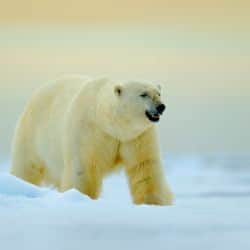Polar Bears At Risk Of Chemical Toxin Contamination

Polar bears are already finding it difficult to deal with climate change. To add insult to injury, these giant Arctic carnivores also face the risk of being chemically poisoned, with levels in region about 100 times above what is considered safe for an adult bear according to the results of a new study. For bear cubs feeding on contaminated milk, the risk is ten times greater than for adults. This means the risk is a 1,000-fold for the baby bears.
Persistent Organic Pollutants
Sara Villa of Italy’s University of Milano Bicocca who was the lead researcher of the study says the research is the first attempt to actually quantify the total risk of persistent organic pollutants (POPs) in the Arctic ecosystem. Ms Villa said that for the study she and her team looked at 40 years of research on the exposure of seals, polar bears and Arctic cod to these lethal compounds. The data included bears living in Alaska and the islands just above Scandinavia. Very little is known about the polar bear population that lives in the Russian Arctic.
Pollutants can stay in the environment for decades
POPs are chemicals that easily spread and can remain in nature for decades, becoming more concentrated as they move up the food chain. By the time POPs travel up the chain from plankton, to fish to seals and ultimately polar bears, the compounds will have accumulated into doses which are highly toxic. These chemicals are used in agriculture and some consumer products. During the 70’s there was a class of industrial chemicals known as PCB’s that were found to cause cancer and caused immense problems with hormones. As a result, they were banned. Despite the ban PCB concentrations in Arctic mammals continued to remain high well into the 90’s, and traces remain even to this day.
Toxicity increases as pollutants move up the food chain
Whilst PCB’s have slowly been eliminated a new family of toxins have replaced them, posing the greatest chemical threat to polar bears according to results of the study. Perfluorooctane sulfonate or PFO’s are considered to be extremely toxic for mammals the study notes. Simultaneously, whilst the bears eat contaminated seals, the concentration of toxins increase 34 times. In contrast to PCB’s these compounds are still being produced and are accumulating in protein, or muscle rather than fat.
Bear cubs are especially at risk.
Even if we fail to consider the latest threats, according to the most recent surveys, the total polar bear population, currently estimated at roughly 26,000 is on track to fall by a third by the middle of this century. The single biggest threat is the rapid decline of sea ice, which polar bears use as floating platforms to hunt for seals. Global warming has meant Arctic temperatures have risen twice as fast as the global average and within a couple of decades we could see ice free summers in the Arctic Ocean.



